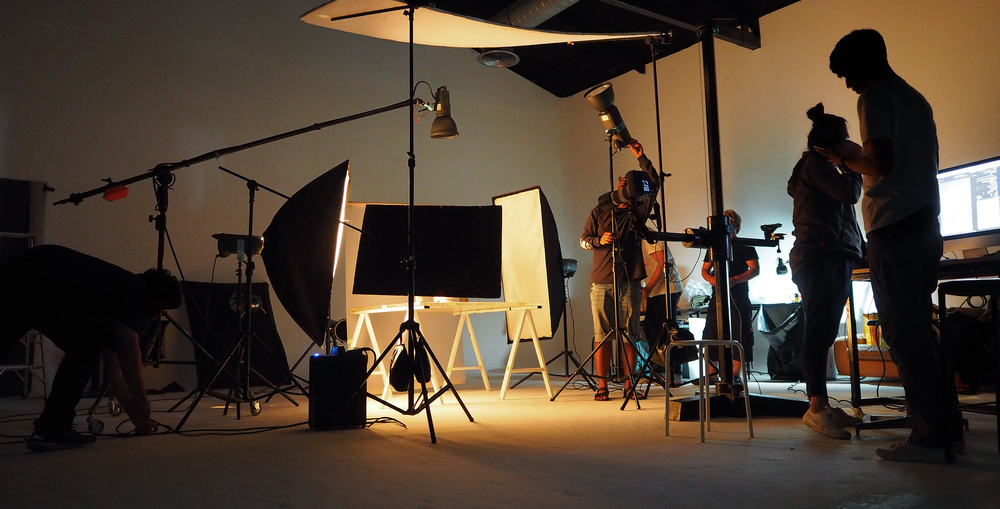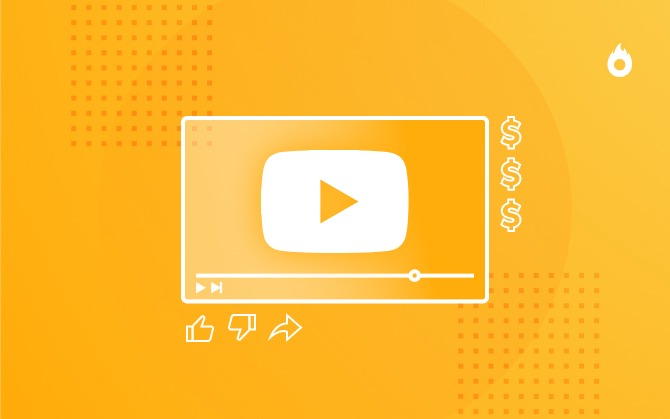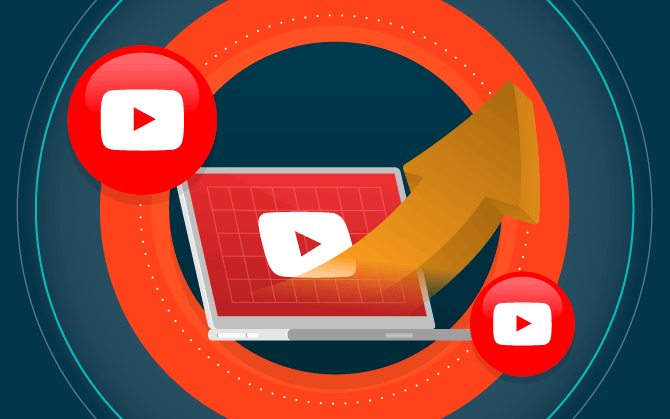
Professional tips on how to improve your YouTube channel’s performance
Find out how to improve your channel with one of our experts.

What will we see in this post
If you want to get subscribers and make your YouTube channel grow, there are several points to be worked out, such as:
- Planning
- Goal
- Content categories
- Upload frequency
- Video duration
- Scheduling grid
- Scripts
- Thumbnails and Titles
- SEO and metadata
In this post, we’re going to talk about all of these items and much more. However, before we start investigating each one, you need to understand the basic principle of the notorious platform algorithm.
The YouTube algorithm
YouTube is a private company and obviously, it needs to be profitable. It does this mainly by selling advertising space on videos and other places on the website itself.
The more time you spend on YouTube, the more ads you see, and the more companies become interested in buying ads.
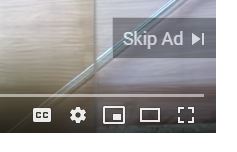
Once you think about this, it becomes clear why it’s important for YouTube to keep viewers watching increasingly more videos on the platform. Thus, the time spent there is worth more than the number of views.
This is where the notorious algorithm comes in, which is nothing more than the formula used in the system with the purpose of evaluating which video keeps people watching longer and which channels attract more people to watch more content, and so forth.
What happens is that this mechanism has become so complex that no one (not even the Google programmers) are able to explain exactly how it works.
What we do know is its ultimate goal, which is no secret to anyone: keep people watching videos longer. In technical terms, increase session time.
Session time goes beyond the display time of a video, which is the metric in YouTube Analytics, calculated in minutes.
A session is the total time that a user spends on the platform. Thus, the algorithm prioritizes content that kicks off short “marathons”, from one video to the next.
Videos that favor this behavior have a good session start and are better evaluated by the system.
As for videos that make people leave YouTube, they present high session end rates. Consequently, the latter are “punished” by the algorithm, which recommends them increasingly less.
Despite this simplified explanation, things are much more complex. Among the points that the algorithm takes into account are other rates, such as:
- Comments,
- “Likes” and an infinity of other metrics.
If you wish to learn more about the subject, we recommend this study by Matt Gielen.
As you can see, the platform’s artificial intelligence decides whether (or not) displaying your videos and channel to a lot of people is worthwhile, or if it’s better to give preference to someone else’s content, which has better success in holding users on the website.
So, before you curse the algorithm, the best you can do is to deal with it and use it in your favor, even if it’s not a perfect model (far from it).
Furthermore, improving your ratings is your goal too, right?
Channel planning
Now that you understand YouTube’s logic, you need good planning, because creating a channel and developing it isn’t unlike creating a business.
Therefore, the first step you need to define is: Who is your audience?
This is a basic question, but carefully evaluating this issue will impact your entire strategy.
When talking about YouTube channels, many people associate them to TV channels, but that isn’t quite true.
On TV, we don’t have thousands of options from which to choose. Therefore, a sports channel covers soccer, volleyball, track & field, swimming, etc.
The internet on the other hand, provides a much more personalized experience, so almost never will anyone subscribe to a channel that covers several sports at the same time. If you like soccer and have the option of subscribing to a channel that covers only soccer, this is probably what you’ll do.
Because of this behavior, it’s very important to only consider one audience. So, don’t keep changing the subject. Define your niche carefully.
For example, a YouTuber who creates videos about makeup might even find it cool to start talking about her newborn baby and the challenges of motherhood. After all, if she has a close relationship with her audience, this shouldn’t be a problem, right?
Actually, this is a very common mistake.
Notice that they are completely different audiences: people who want to learn about makeup and people interested in motherhood.
Part of the audience might even be interested in both subjects, but this mixture of subjects will not bring more people to the channel.
The YouTuber in the example also runs the risk of displeasing a good portion of her audience, which subscribed only for her makeup videos.
If the insists on mixing subjects, part of the audience that used to click and watch all content will only watch those videos about makeup (half of the uploads) and many potential subscribers will see the channel as a mixture of subjects.
For these new viewers, there will be no advantage in subscribing; after all, no one wants to receive content in which they aren’t interested.
Thus, the algorithm notices this change in dynamics and starts to evaluate the channel poorly, assuming that it no longer pleases the majority of subscribers and doesn’t attract as much interest from users who come across the content.
So now, you can see where this is going, right?
YouTube starts giving preference and favor your competitors who, according to the algorithm, are more likely to hold people watching.
The goal (what do you deliver?)
Now that we’ve made the importance of having a single audience clear, also consider your channel’s goal from your viewers’ perspective. In other words, “reaching an x number of subscribers or views” isn’t a useful goal from a strategic point of view and doesn’t tell you much about your audience.
So think about why someone would subscribe to receive your content and the value you wish to deliver.
Once again, this seems like a simple question, but it’s very hard to dissociate our view as creators from an external or, the audience’s view.
If in doubt, try the “so what?” test: evaluate if your content is aligned with your viewers interests and with what the channel proposes.
Help (or Hygiene), Hub and Hero categories
Since we’re talking about content, YouTube itself recommends its Creator Academy, a type of classification to structure planning. We’re talking about the following categories:
- Help
- Hub
- Hero
In short, it deals with the definition of which content will make viewers come to you (Help), which will serve to improve your relationship with your existing audience (Hub) and which will serve to find new viewers (Hero).
Despite this type of classification not being applied to all cases, it can be a good point of reference.
As we’ll detail below, the recommendation is that you produce constant Help videos, occasional Hub videos, and only a few Hero videos.
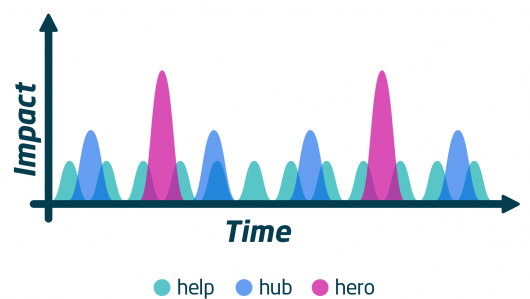
Help content: act like a teacher
First of all is the Help category. As the name says, it’s the type of content that helps users. This is where the “how to do” tutorials come in.
The great advantage of this type of video is that it benefits greatly from the YouTube search engine. In other words, if someone enters a question on the site, chances are this person will come across your video. Remember that this is one of the main uses of YouTube.
This feature of working “searchable” content is a major advantage in comparison to Facebook, Instagram, WhatsApp and other networks.
Thus, you make your viewers come to you on their own. Remembering that YouTube is the second largest search engine in the world, only behind Google, which is the same company.
A video categorized as Help might not be successful at first, but its performance is likely to improve over time as more users search for solutions on the network.
Overall, content to teach and help viewers should be make up most of your YouTube channel, especially if it’s about a type of business.
If this post were a video, it would certainly be in the Help category.
This category can also be called Hygiene, meaning something done daily or a process of constant maintenance for your channel’s “health”. This term serves to cover content that doesn’t necessarily help viewers, but are routine.
For example, on a music channel, Hygiene content might include covers and not necessarily tutorials teaching songs.
This logic also applies to comedy, vlog or gameplay channels.
Hub content: act like a YouTuber
Hub classification refers to content seeking to establish a conversation and connection with the audience already subscribing to the channel.
Good examples are videos in a more personal style, such as vlogs, live streams or Q&A’s.
This type of content serves to create a community and make your fans even more connected and engaged.
Because it’s a type of video that only makes sense to an existing audience, it’s best to use it less often.
Thus, only invest on Hub content after the channel already has a considerable audience, which demonstrates a greater willingness to connect, by commenting and actively participating in your posts.
When using Hub content, always be careful so as not to lose the channel’s focus.
If you talk about cooking for example, make a video talking about how you got started and became interested in the subject, or tell amusing stories related to cooking. This will certainly work better with your audience than making a video where you talk about your new dog.
Extra tip: use the Community tab and YouTube Reels (similar to Stories) to interact and understand your audience better.
You can also use elements such as polls and add questions in comments attached at the top.
When you communicate with your audience by means of these resources, you’ll also understand your audience better and thus, improve your content for them.
Hero content: act like an advertiser
Finally, we have the Hero content, which is created to reach an audience who still hasn’t had contact with your YouTube channel.
A video in this style seeks a greater reach of new viewers; therefore, the idea here is to create something that has great potential for expansion.
This type of video can also be made with the purpose of being displayed as a suggestion recommended by YouTube.
With something in the Hero style, more people will come across your channel and you can get many subscribers in a short time.
Making this type of video isn’t easy and we recommend that you make only a few a year, since they might not work in the long run and usually consume more resources, production and planning time.
In addition, they might not be interesting for your established audience.
In order for content in this style to be successful and actually work for the channel, first, you need a solid foundation of Help videos and a few Hub videos to ensure that not only do you have useful content, but also an engaged community that helps you attract new subscribers.
When planning Hero content, take into account that you’re advertising the channel, albeit indirectly.
These videos benefit greatly from “viral” results, but as we know, investing in making content go viral is a crapshoot. So, focus only on doing something with a potential of reaching new audiences.
Take advantage of events and commemorative dates and investigate niches related to your own in order to create related content.
Be creative
The most important thing here is to be imaginative and attract the audience’s attention.
As an example, if you like comedy and own a channel on financial education, how about creating a video clip parodying a hit song, while you talk about something related to your channel’s theme?
Once again, in order to demonstrate with a Hotmart example, the video with Anitta’s talk at Fire Festival 2018 worked extremely well in this sense. After all, a chat about entrepreneurship with one of Brazil’s greatest young artists draws attention and makes many people who didn’t even know the channel, have contact with the Hotmart brand.
Another strategic factor that helped in the video’s reach and success was the data it was posted, taking advantage of the attention she was receiving due to the release of a Netflix documentary about her and also her new video clip.
YouTube also suggests another way of classifying your videos, which is by defining if your goal is to educate, inspire or entertain.
Notice that the majority of channels fits into one of these categories and they can help you define your brand persona better.
Evaluating this type of classification will also help you maintain your channel’s goal.
These classifications, as well as those we mentioned earlier, are not rules and don’t need to be so strict. It’s also possible to mix them up and adapt them, but keeping these divisions in mind can help you a lot when you set up your planning.
You can also create different playlists or limited video series based on these divisions, if applicable.
Also remember that, ideally you should focus on specific indicators for each goal.
- Do you wish to expand your audience reach? Focus on the sharing metrics.
- Do you wish to establish a connection with your audience? Focus on comments.
- Do you wish to provide your audience with useful content? Focus on “likes”.
These are only basic guidelines to measure the success of your actions on your YouTube channel.
Upload frequency and video duration
And now, a question that many people ask, “Do I need to post videos every day?”
No. But for a long time, many people invested in this tactic, and in many cases, it actually works.
As we’ve mentioned before, YouTube gives preference to content that keeps users on the platform. So, if you post more videos, the possibility of keeping people watching your channel will be greater, right?
In addition, new videos tend to be part of users’ recent history and this is well evaluated by the algorithm, which considers that your channel is relevant for the moment and consequently, recommends it even more.
However, since everything has its negative side, be careful. If you post every day, you risk compromising the quality of your content and this will cause people not to watch your videos until the end.
Thus, the average duration of visualization is reduced and the algorithm understands that your content isn’t the best one to be suggested.
Another thing that might occur is that your audience isn’t able to watch all the videos posted. Again, YouTube understands that your channel doesn’t generate as much interest in subscribers and will start “dropping it to the bottom” of recommendations and ranking.
This is why it’s important to be careful with these tactics, or the so-called hacks, since they can backfire.
Now it’s easier to understand why, in theory, it’s better to make longer videos, since it can generate longer display time, right?
You can invest in this idea, but you risk not holding your audience for long, generating low retention and making the algorithm understand that your content is bad.
Another possible disadvantage refers to session time.
After watching a very long video, viewers tend to leave YouTube, generating more session ends. As we’ve seen earlier, the platform doesn’t want this.
Therefore, we recommend that you focus on quality and make videos with great content, whether short or long.
Don’t push it and over-summarize (creating superficial content), and don’t try to lengthen your video unnecessarily, because this will make it too lengthy and uninteresting.
If you have no idea of what video size to start with, try keeping it within 6 to 8 minutes.
If you already have a channel with a considerable number of posts, use the average view duration number in YouTube Analytics as a reference point to adjust the duration of your videos.
As to uploading frequency, it also varies according to the audience and type of channel, but about twice a week is usually enough. Here, your production capacity will also influence a lot. The most important thing is consistency.
Content scheduling (grid)
More than thinking about frequency, it’s important to have a clear schedule. In other words, establish a relationship with your audience and be consistent.
If you decide to post videos every Wednesday at 3:00 pm, be consistent. This demonstrates commitment and creates engagement. And if your audience knows precisely when you’ll be posting, the possibility of them missing any content is much smaller.
Many channels use their cover image to inform the schedule, inserting a text, such as “new videos every Monday and Wednesday at 3:00 p.m.”
In order not to get tangled with your schedule, try recording several videos at once and then edit and release them gradually.
Establish a schedule and if possible, plan the scripts beforehand and set aside time in your day to record them. This way you save production time, since adjusting all the equipment, setting up your sets and selecting wardrobe may take hours.
With this suggestion, you can do everything at once and save time.
Scripts
The development of scripts varies extremely according to the channel, but the main recommendation here is, don’t beat around the bush.
Remember that you’re competing with other channels and videos all the time, so it’s important not to disrespect your viewers’ time.
You don’t need to script your entire video; after all, many people improvise or only use simple bullet points as a guide.
But, always pay special attention to your introductions. The first 10 sections are crucial to retaining your audience.
At the beginning of the video, briefly explain what you will address. No one wants to wait several minutes to find out if they clicked on the right video. Thus, you prevent the retention rate from dropping too much.
Evaluate the absolute and relative retention charts to understand if your introductions are working well.
For your introduction, you can pique viewer curiosity or create an expectation with a different scene. It’s worth mentioning that, at the end, the person will be able to solve the problem in question (if that’s the style of the video).
Now, in terms of video endings, whenever the content is coming to its end, avoid using words and expressions that imply that the video is ending, such as “so, this is it” or “and finally”, so that viewers don’t close the video before its complete end.
Thus, you hold your audience for more time and can also take advantage of the elements on the last screen, which can be added during the last 20 seconds of each video. A few options are:
- Subscription button,
- Videos,
- Playlist,
- Cards.
These elements can help you guide viewers to further action.
Another tactic is asking your audience to comment or subscribe. It’s worth testing these actions at different video times to see what works better for our and your audience.
Thumbnails
You video cover images (thumbnails) are extremely important for a good performance.
Ideally, they should portray the content well. One tip is to use the same logic as movie posters.
For example, with superhero posters, a quick glance gives you a good idea of the characters involved, the sets and the general mood.
Also, think about the visual identity of these images and of the channel as a whole. Ideally, you should create a consistency of style that helps your viewer know that it’s one of your videos, just by glancing at the screen.
Using the same color palette, fonts or always inserting your logo are excellent practices.
Thumbnails can also be used to create viewer curiosity. Working them in a creative manner, always related to the content, can ensure many clicks.
The image above emphasizes the face of the interviewee, complements the title with textual information and includes curious elements related to the video: the unusual expression of the guest and the falling Jenga tower.
It’s important not to confuse the tactic of attracting attention with click-baiting. The effect create might be quite negative, because if the viewer feels cheated and leaves the video immediately after clicking, the algorithm evaluates this behavior poorly and reduces your content’s recommendations.
In order to learn more about how to create your thumbnails, make sure you read our other posts on the Hotmart blog.
Titles
When we talk about video SEO (search engine optimization), the title is probably the most important item.
Along with thumbnails, they share most of the responsibility for attracting clicks. So, pay close attention to the words you use and don’t rush it.
Ideally, you should create many alternatives for the ending and select the best one.
Evaluate the titles of competing videos and auto-complete suggestions YouTube provides (do this in an anonymous tab in your browser so that your navigation history doesn’t interfere with the results).
Also use Google Trends to compare terms.
Whenever possible, place the main keywords at the beginning in order of importance.
You can choose to use the main term in upper case to emphasize it.
Also pay attention to the size of the title. Remember that many people access YouTube on their phones with small screens; therefore, this text will usually be incomplete for users. Smaller titles (up to 50 characters) tend to perform better.
As a reference, a video version of our post, How to get YouTube subscribers could have the following options:
- How to GET YouTube SUBSCRIBERS.
- YOUTUBE SUBSCRIBERS: how to get more.
- GETTING YouTube SUBSCRIBERS: how to get them.
In the case of video series, one option is to add the series name at the end of the title.
Enumerating the content is also an interesting option, because it shows viewers that they can go to other related posts.
Thus, if the previous example were part of our series called Hotmart Tips, it might look like this:
- How to get YouTube subscribers? | Hotmart Tips #70
In certain cases, your video’s theme might have a low volume of searches and not be very attractive for your audience. In these cases, you can tweak with your strategy and invest more in good copy rather than in SEO.
Do this by appealing to your viewers’ emotional side or by piquing their interest. In order to learn more about copywriting in general, make sure you read our post about the subject.
Note: Use the same video title as the name of the file in question. In our example, instead of uploading a video called “subscribers_video_final.mp4″ it would be more appropriate to call it “how_to_get_YouTube_subscribers.mp4″, since this textual information can also be used by the platform as metadata.
SEO and metadata
Also regarding SEO, other items must be considered, such as tags and descriptions.
This metadata has far less influence in the performance of a video than its theme, title and thumbnail, but you should work on it a lot anyway.
We recommend the VidIQ tool to help you with this information. Just go to their website, create an account and installed the Chrome extension.
Tubebuddy is another plugin that can help you with this, and also help you manage your channel.
Tags
Regarding tags, focus on the main one, which is the one that is more relevant to the theme of the video and repeat it with different additions in order to reinforce focus.
For example, in a video where the theme is “get YouTube subscribers”, the tags could be:
- Subscribers
- YouTube subscribers
- How to get subscribers
- Channel subscribers
- More subscribers
- Increase subscribers
- Grow subscribers
- Improve subscriber numbers
- Get subscribers
- Attract subscribers
This form of “surrounding” the main term works better for the algorithm to be certain about the video’s subject and to recommend your content more successfully and to the right audience, but you can always add other related terms.
Descriptions
Descriptions also help viewers and the algorithm to evaluate your content.
Consider these texts as a type of blog mini post about your video.
We recommend that you carefully describe what was presented – and you don’t need to be afraid of giving spoilers, because the more you talk about the subject, the better.
Try to create something with at least 300 characters, and as with scripts, go straight to the point and don’t beat around the bush.
Certain experts recommend adding the entire video transcript in the description.
In case of long videos or of those that cover several subjects, consider using timestamps, which will serve as an index. Just enter the time in hours, minutes and seconds (separated by colons, and YouTube will create a shortcut that takes you to the video section in question.
Also add the links to your other networks and websites next to the section.
Subtitles
YouTube also allows you to add subtitles to videos, which contributes to the SEO and helps the algorithm to understand your content.
In addition, subtitles are essential to make your videos more accessible to people who have problems hearing, as well as for viewers in situations where turning on the audio is unfeasible (public transport and places that require silence, for example).
In the video manager, YouTube’s editing screen, you can access the subtitles/CC tab and include the text.
There, you’ll find an option to manually transcribe, add the appropriate file (.srt, for example) or simply paste your script and use one of the best features for subtitles, which is YouTube’s automatic synchronization.
Remembering that the platform generates the automatic subtitling of the videos – often quite imprecise –, but that can be used as a basis to facilitate the transcription.
Some time after uploading, they will be available and you can download them by clicking on the three dots next to the “save” button (lower right corner of the video player. Then, you just have to go to “open transcript” and copy the text you created.
Extra tips
Now that we’ve seen the main points, there’s a series of little tips that can help you improve your results that are worth highlighting.
Share links through playlists
When you promote your content on external websites and social media, go to the playlist page on YouTube and copy the video’s link from that screen. This way, viewers will watch the content through the playlist, which will lead to more related content.
Use series playlists
A different type of playlist is the series, which is very useful for content that has continuity. This way you can define seasons and episodes.
These videos will tend to play in sequence, which will guide the viewers’ experience better.
Check the source of traffic
Many people may arrive at your channel through recommendations from other videos, or through searches on the platform itself.
Carefully evaluate this data about the source of traffic in YouTube Analytics, especially regarding suggested videos and YouTube searches. This is a great way of understanding what your audience wants and who your competitors are.
Use the Premiere feature
A great way of calling attention to special videos is by using the YouTube premieres. With it, you upload your video and send notifications to your audience half an hour before the video is officially posted.
At the time of posting, another notification is sent, ensuring that your viewers don’t miss the video and also creating an effect similar to live streams, where several people watch at the same time.
Test thumbnails
After you post the video, it’s worth testing to see which image works best, since the thumbnail is the only thing we recommend tinkering with immediately after posting.
This is due to the fact that other metadata (title, tags and descriptions) are used by the platform to try to understand and classify your content.
If you keep changing this information in a recent post, you might interfere with the algorithm calculations. So, there’s a high chance that your video’s performance will be affected.
Track click-through rates (CTR)
Titles as well as thumbnails can be evaluated by using the CTR and impressions metrics. Their importance and influence is so great that we’ve created a text just to talk about these numbers.
In short, they evaluate the interest that you content creates with viewers, so that they will actually click on the videos.
In order to get subscribers for your YouTube channel, you’ll need views, and to get views, you first need to attract viewers. Thus the importance of evaluating click-through rates and impressions.
Use cards
During your videos, you can use cards to recommend other videos or direct users to an external website, which must be registered in your account.
Despite being a great way of inducing a journey, remember that by doing this, you risk reducing your video and platform retention time. So, use these features sparingly.
Don’t forget the end screen elements
Like the cards, the end screen elements help guide the viewer’s journey.
During the final 20 seconds of your content, you may include video, playlist and card suggestions.
As mentioned earlier, be careful with video endings, to ensure that viewers don’t leave early.
Pay attention to comments
It’s super important to interact with your viewer base in the comments. Make an effort to reply to everyone in a timely fashion.
These interactions are well regarded by the platform and consequently, help you have greater connection with your audience.
If you have to deal with a very large volume of comments, try to at least mark the thank-you post or positive comments with a “heart”, which don’t necessarily require an elaborate response.
This way users receive a notification of your interaction and know that their messages were read and appreciated.
Create a trailer for your channel
Create a short video talking about what viewers will find on your channel and highlight it on your home page. With this, the chances of convincing new arrivals to subscribe.
You can use this video para to create a trueview ad if you wish to venture into paid strategies.
Find the best days and times to post
If you already have an active channel, go to YouTube Analytics and evaluate the amount of views over the course of days. You can do this through the Display Time tab by clicking on views and evaluating the chart.
To make this easier, choose to see only data relative to the last 90 days (or less). This way you can identify any patterns in the peaks and valleys and thus, find the days of the week with more and less views.
The real time tab can also help you identify the best times. To do so, monitor the charts over the last 48 hours for a few weeks and see if there’s a pattern that can indicate the best times to post.
This information can be a good ally when it comes to view velocity, since the algorithm evaluates the good performance of a new upload during the first hours of posting in order to know whether or not to continue increasing that video’s impressions.
This reinforces the importance of having a great CTR.
Assess your competition
We’ve already talked about how analyzing suggested videos can be useful to understand your audience’s interests better. This is also a great way of investigating potential competitors.
Go the YouTube search (by means of an anonymous tab or private window) and enter the main terms related to your channel and analyze the results.
This practice can help you identify themes for videos related to your niche, which is a great way to get ideas for new content.
Collab
You have probably already heard about collaborations between YouTubers, right?
This involves inviting another content creator to participate in a video on your channel and vice versa.
This is definitely a great way of getting subscribers. So, don’t think of other channels similar to yours as merely competitors, because you can become good allies.
Remembering that for this strategy to work, and for you to effectively get subscribers, you need to work with channels with similar audiences.
You’ll also need to evaluate the size of your possible partnering channels, because if their audience is much larger than yours, they might not find the collaboration as interesting for them.
In the same way, collabs with channels that are much smaller than yours, might not generate results.
Invest in hybrid formats
If you’re an avid user of the platform, you have certainly noticed that several successful channels invest in well-defined video formats, for example:
- Listings (“top 10”, compilations, shopping experiences)
- Explanatory videos (scientific videos, tutorials, educational content)
- Opinion videos (vlogs, unboxing/reviews, conspiracy-theory videos)
- Interviews (celebrities, life stories, comedy)
- Music clips (official, covers, parodies)
- Reactions (practical jokes, quizzes, magic/hypnosis)
- Narrative (web series, parodies, skits)
If possible, invest in mixing the items above in order to create more original content with better chances of attracting viewers with the format. Thus, you won’t be dependent on specific topics, which will make users become interested in all videos of the series (or channel).
Final considerations
Even with all these tips, the most important thing to make your YouTube channel grow is consistency.
It’s also worth mentioning that despite the many good practices and tutorials there are about how to get subscribers, the quality of your content should be paramount. And we are talking about information, text and delivery of value.
Production quality (especially image) doesn’t solve the problem of bad content, and most of them times, it’s by no means a requirement for a successful channel.
So, don’t spend too much time and effort thinking about sets, editing techniques and thinking about buying expensive equipment – unless your niche requires it.
Other factors that greatly influence this medium are: charisma and personality. It’s not uncommon to find channels that don’t follow most of the tips explained here, but that are still quite successful because they rely on captivating personalities.
Unfortunately it’s hard to measure and work on these points, but always try to be natural and spontaneous.
In the beginning, it’s normal for your posts not to come out very well, but just search the first videos of most of the successful channels and you’ll find that it’s a gradual process of evolution.
The more you practice, the better your videos will be.
After all these tips, you should know that you’ll need a lot of patience because it’ll probably take some time before YouTube understands and evaluates your channel, and prioritizes it on the system.
A great way of measuring your progress is by using Social Blade. With this website, you can follow the statistical evolution of your channel, and also of your competitors, also analyzing future predictions.
With this long text, you’ll certainly already have a good foundation to start working on your YouTube channel. How about also worrying about your video production?


